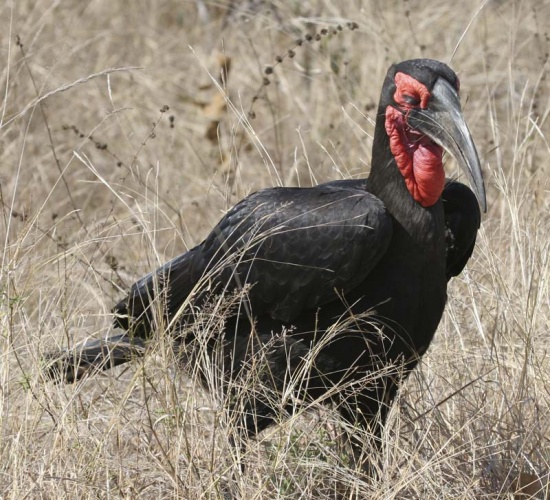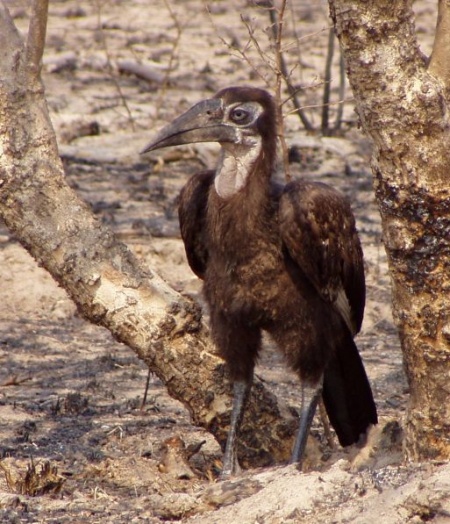(Image of juvenile and text added) |
(voice) |
||
| Line 1: | Line 1: | ||
;[[:Category:Bucorvus|Bucorvus]] leadbeateri | ;[[:Category:Bucorvus|Bucorvus]] leadbeateri | ||
[[Image:Southern_Ground-Hornbill.jpg|thumb|550px|right|Photo by TwoBoy.]] | [[Image:Southern_Ground-Hornbill.jpg|thumb|550px|right|Photo by TwoBoy.]] | ||
| − | [[Image: | + | [[Image:2005_0927_Juvenile_Southern_Ground_Hornbill_Alan_Manson.jpg|thumb|450px|right|Juvenile Southern Ground Hornbill<br>Photo by Alan Manson<br>[[Kruger National Park]], [[South Africa]] ]] |
''Bucorvus cafer'' | ''Bucorvus cafer'' | ||
==Identification== | ==Identification== | ||
| Line 11: | Line 11: | ||
'''Juvenile''': The plumage is sooty brown, and the bare facial skin is dull cream to yellow. | '''Juvenile''': The plumage is sooty brown, and the bare facial skin is dull cream to yellow. | ||
| + | |||
| + | The voice is a deep, booming ''hudu hudu hududu'' that can be heard over a distance of three kilometres. | ||
==Distribution== | ==Distribution== | ||
[[Africa]]: Southern [[Democratic Republic of Congo]], [[Uganda]] and southern [[Kenya]] in the north, to northern [[Namibia]], northern and eastern [[Botswana]], eastern [[South Africa]] and [[Swaziland]] in the south. | [[Africa]]: Southern [[Democratic Republic of Congo]], [[Uganda]] and southern [[Kenya]] in the north, to northern [[Namibia]], northern and eastern [[Botswana]], eastern [[South Africa]] and [[Swaziland]] in the south. | ||
Revision as of 09:04, 17 June 2008
- Bucorvus leadbeateri
Bucorvus cafer
Identification
The Southern Ground Hornbill is a large bird; at 90 to 129 cm (36 to 51 in) long and a weight of 3.2 to 6.2 kg (7-13.6 lbs), it is the largest species of hornbill. Males are larger than females.
Adult male: Characterized by black plumage and vivid red-coloured face and throat patches (yellow in juvenile birds). The white tips of the wings (primary feathers) seen in flight are another diagnostic characteristic. The beak is black, straight and presents a casque.
Adult female: Has a smaller bill and casque than the male, and a small blue throat patch.
Juvenile: The plumage is sooty brown, and the bare facial skin is dull cream to yellow.
The voice is a deep, booming hudu hudu hududu that can be heard over a distance of three kilometres.
Distribution
Africa: Southern Democratic Republic of Congo, Uganda and southern Kenya in the north, to northern Namibia, northern and eastern Botswana, eastern South Africa and Swaziland in the south.
Taxonomy
The Southern Ground Hornbill and the Abyssinian Ground Hornbill are the only two species in the genus Bucorvus.
Bucorvus leadbeateri is monotypic.
Habitat
Its habitat comprises savannahs, woodlands and grasslands.
Status
The Southern Ground Hornbill is a vulnerable species, mainly confined to national reserves and national parks. Conservation efforts include captive breeding, as well as projects where second-hatched chicks (which soon die in the wild as they cannot compete for food with the older chick) are removed from the nest and have been successfully hand-reared and reintroduced to the wild.
Behaviour
They live in groups of five to ten individuals including adults and juveniles. Often, neighbouring groups are engaged in aerial pursuits. They forage on ground, where they feed on reptiles, frogs, snails, insects and small mammals.
Breeding: Monogamous and a cooperative breeder; the dominant pair may have as many as nine helpers. Most nests are in a cavity in a dead or live tree; the nest is not sealed by the male, as is done in other Hornbill species. One or two eggs are laid August to January. The eggs hatch asynchronously, and only one chick survives in the wild. Juveniles are dependent on adults for 6 to 12 months, but generally remain with the parental group for several years.
References
Hockey PAR, Dean WRJ & Ryan PG (eds) 2005. Robert's Birds of Southern Africa, 7th edition. John Voelcker Bird Book Fund, Cape Town, South Africa. ISBN 0620340533





